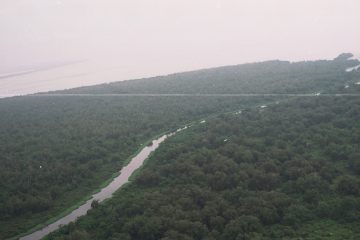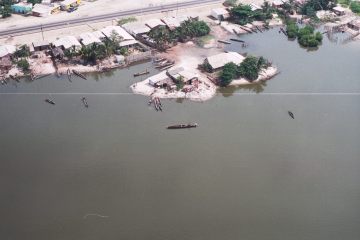http://webdoc.sub.gwdg.de/ebook/dissts/Bremen/Leal2007.pdf
In tropical coastal ecosystems very little is known about the impacts of non-native fish species on the native ichthyofauna and to the author’s knowledge, there are no published studies in Caribbean estuaries. The Ciénaga Grande de Santa Marta estuary (CGSM), at the Caribbean coast of Colombia, has been affected by human intervention that altered the hydrological regime causing the loss of valuable resources. Formerly interrupted water connections were reopened in 1996-1998 to reestablish hydrological conditions, but as a side effect the occurrence of non-native fishes augmented in the estuary. Since its accidental introduction in 1995, Nile tilapia (Oreochromis niloticus) ranks among the most commercial resources, accounting for more than 60% of the catches until 2001, but decreasing thereafter to less than 10%. In contrast, the occurrence of snakeskin gourami (Trichogaster pectoralis), first registered in 1989, has been lower but more regular than that of Nile tilapia.
This study aims to determine the impacts of O. niloticus on the abundance, species composition, feeding habits and fishery of native fishes, and the impacts of T. pectoralis on the abundance of native ichthyofauna. Catch per Unit Effort (CPUE) data was used as a measure of relative abundance of different species in the ecosystem from 1994 to 2003. The data sets were divided into four periods (I=1994-1995; II=1996; III=1999-2001; IV=2002-2003). Additionally the study area was divided into four zones following an eastto-west gradient of increasing salinity. The abundance of the native fishes combined was relatively constant and did not seem to be affected by the “boom” of Nile tilapia during the years 1999-2001. Instead, this fish represented a large addition of biomass into the system. However, on the species level, composition and abundance changed from period to period. Analyses of similarity (ANOSIM) and similarity percentage (SIMPER) revealed that O. niloticus modified the fish composition, dominating all zones during the period of lowest salinity (1999-2001). In contrast the native estuarine fish Mugil incilis was dominant in all other periods in the entire estuary. A decrease in native fish diversity coincided with high abundance of Nile tilapia. Multiple regression analyses revealed that changes in abundance of two native estuarine fishes, Cathorops mapale and Megalops atlanticus, were related to the abundance of Nile tilapia, and that changes in abundance of two native estuarine fishes, Ariopsis bonillai and Elops saurus were related to the abundance of T. pectoralis. However, multiple regression analyses also revealed that mostly salinity and, to a lesser extent, pH and river discharge regulate the distribution and abundance of all studied fishes, including O. niloticus and T. pectoralis.
The analyses of diet composition (e.g. index of relative importance), diet evenness (J’) and diet breadth (H’) in periods before and after the introduction of Nile tilapia, revealed that most native fishes and O. niloticus were mixed feeders with certain degree of specialization in two or three food categories. Few native fishes were either generalists or specialists. All fishes fed on the most abundant preys, which mostly belong to low levels in the food web, in both periods and changed their feeding habits according to prey abundance. Multiple regression analysis showed that mainly salinity is the factor that regulates the abundance of most common preys in the estuary. A moderate diet overlap was observed between O. niloticus and Diapterus rhombeus, but this is most likely due to high abundance of their common preys: detritus and phytoplankton.
The fishery of Nile tilapia, a relatively low-priced fish, provided a six times greater economic revenue than all native fishes together during the period 1999-2001. However, a questionnaire-based survey revealed that fishermen prefer the fishery of native estuarine fishes due to their better taste and price. An analysis on the species level showed that economic revenues derived from the most valued native species decreased during the period of highest abundance of O. niloticus and lowest salinity in the estuary. In contrast, the native estuarine fish Mugil incilis kept a relatively high price and abundance, thus providing relatively high economic revenue during the whole study period. Multiple regression analysis showed that salinity is the main factor explaining the variation of economic revenue derived from most native fishes. Nevertheless, differences in market structures have also an important influence on economic revenues.
No clear evidence has been found that indicates a negative impact of O. niloticus and T. pectoralis on the abundance and species composition of the native ichthyofauna. Additionally competition for food between O. niloticus and the native fishes does not seem probable due to the high abundance of their shared preys and the generalist and mixed feeding strategies of most native fishes. In fact, the fishery of O. niloticus represented an alternative income during a period when the most valued native fishes were scarce. However, there are indications of a high probability of negative impacts to occur: the proliferation of the Nile tilapia modified the species composition of the native fish communities dominating during a period of low salinity, and a potential impact on native benthic fish and fish biodiversity of the estuary can not be ruled out. Oreochromis niloticus and T. pectoralis have biological features that facilitate their proliferation in new environments and food resources seem not to be a limitation. However, until now their long term establishment seems to have been restricted by drastic environmental fluctuations (e.g. salinity) in the estuary. Three possible scenarios, or a combination of them, could favor the long-term proliferation of oligohaline alien fishes like O. niloticus and T. pectoralis: 1. A longer duration of relatively low salinity periods, 2. The introduction of more euryhaline strains of O. niloticus from aquaculture installations in the area, or 3. The adaptation of non-native fishes to the variable environmental conditions of the estuary.
The findings indicate that the establishment of alien fishes with opportunistic feeding habits in tropical estuaries with a high environmental variability is more influenced by abiotic factors than biotic interactions like competition. However, further research should be conducted to establish the role of other biotic interactions (e.g. predation, competition for space, facilitation) and human factors like overfishing on hindering naturalization of non-native fishes in this type of ecosystems. The relative constancy of the overall abundance of all native fishes combined in the estuary suggests a high resilience of this component that might be related to a high species redundancy within functional groups. Further research is needed to identify those functional groups and determine their importance for ecosystem functioning. Additionally, some gaps of knowledge in the biology of native fishes should be filled to avoid negative side effects of measures aiming to control introduced fish populations in the estuary.
Este trabajo es la base de la publicación: Leal-Flórez, J., Rueda, M., & Wolff, M. (2008).




